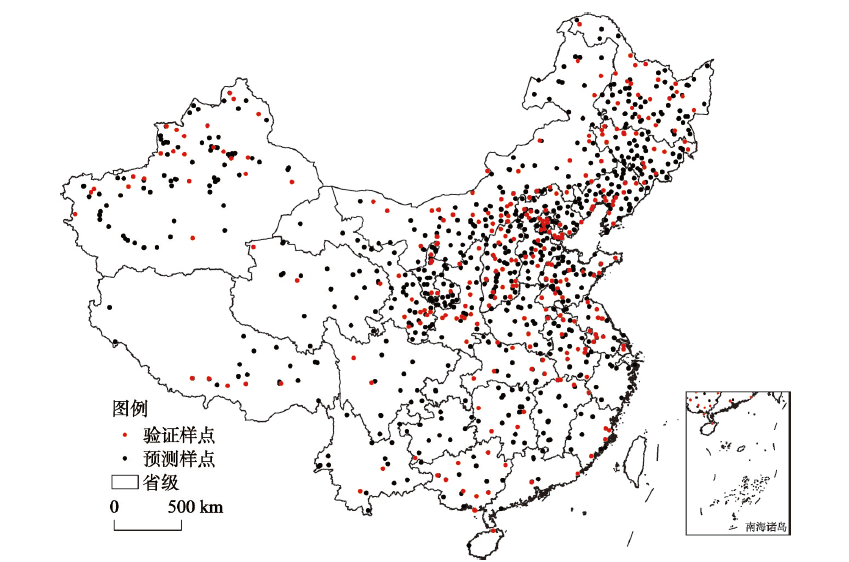

1951—2010年中国土壤温度时空变化特征及其影响因素
|
张天鹏(1996-), 男, 吉林松原人, 硕士生, 主要从事农业面源污染研究。E-mail: ztp_yy220722@163.com |
收稿日期: 2021-03-10
要求修回日期: 2021-12-31
网络出版日期: 2022-05-23
基金资助
国家自然科学基金项目(U20A20114)
版权
Characteristics of spatio-temporal changes in soil temperature in China from 1951 to 2010 and its influencing factors
Received date: 2021-03-10
Request revised date: 2021-12-31
Online published: 2022-05-23
Supported by
National Natural Science Foundation of China(U20A20114)
Copyright
土壤温度状况对于研究气候变迁、地球物质能量循环以及土壤性质演变具有重要意义,但目前对国家尺度上土壤温度状况的长期序列和空间变化缺少研究。因此,本文基于土壤温度内插法和地理加权回归(GWR)模型,使用1951—2010年中国880个气象站点的观测数据,研究了中国土壤温度状况时空变化特征及其影响因素。结果表明:① 中国60年来土壤温度变化整体趋势为东北地区升温,西南地区少部分地区降温;② 中国土壤温度状况可划分为冷性土壤温度状况(东北地区、青藏高原地区和内蒙古东部)、温性土壤温度状况(新疆南部、内蒙古和山西南部以及山东)和热性土壤温度状况(华中、华东、华南以及西南的云南、贵州和四川);③ 经纬度和气温与土壤温度具有良好的响应关系,其中气温是最重要的影响因素;④ 中国60年来整体呈现温性土壤向北迁移(约46.5 km)、冷性土壤向南迁移(约43.4 km)的趋势。研究结果可为地理学、土壤学等相关领域深入研究提供一定参考,并为土壤系统分类研究提供理论依据。

关键词: 土壤温度状况; 地理分区; 地理加权回归(GWR)模型; 时空变化; 影响因素
张天鹏 , 保万魁 , 雷秋良 , 刘笑彤 , 杜新忠 , 周脚根 , 罗加法 , 刘宏斌 . 1951—2010年中国土壤温度时空变化特征及其影响因素[J]. 地理学报, 2022 , 77(3) : 589 -602 . DOI: 10.11821/dlxb202203007
The soil temperature status is of great significance to climate change, the earth's material energy cycle, and the evolution of soil properties. However, there is currently a lack of research on the long-term sequence and spatial changes of soil temperature status on a national scale. Therefore, based on the soil temperature interpolation method and Geographic Weighted Regression (GWR) model, this paper used the observation data of 880 meteorological stations in China from 1951 to 2010 to study the characteristics of the spatio-temporal changes of soil temperature in China and its influencing factors. The results showed that: (1) The overall trend of soil temperature changes in China over the past 60 years increased in the northeast and decreased in a few areas in the southwest; (2) The soil temperature in China can be divided into cold soil temperature status (Northeast China, Qinghai-Tibet Plateau and eastern Inner Mongolia), temperate soil temperature status (southern Xinjiang, Inner Mongolia, southwestern Shanxi and Shandong) and thermal soil temperature status (central China, eastern China, southern China, and Yunnan, Guizhou and Sichuan in Southwest China); (3) Longitude, latitude and air temperature had good responses to and relationships with the soil temperature, of which air temperature was the most important influencing factor; 4) Over the past 60 years, there was a trend of warm soil regime migrating to the north (approximately 46.5 km) and cold soil regime to the south (approximately 43.4 km). The research results can provide a certain reference for in-depth research in related fields such as geography and soil science, and a theoretical basis for the study of soil systematic classification.

表1 土壤温度克里格插值拟合空间变异参数Tab. 1 Kriging interpolation of soil temperature to fit spatial variability parameters |
| 参数 | 理论模型 | 块金值 | 基台值 | 块金值/基台值 | 步长(m) | 决定系数R2 | 离差平方和RSS |
|---|---|---|---|---|---|---|---|
| 土壤温度 | 球状 | 0.025 | 0.262 | 0.096 | 55510 | 0.998 | 0.0908 |
表2 中国年均土壤温度的描述性统计Tab. 2 Descriptive statistics of the average annual soil temperature in China |
| 项目 | 平均值(℃) | 中值(℃) | 标准差(℃) | 变异系数 (%) | 偏度 | 峰度 |
|---|---|---|---|---|---|---|
| 模拟值 | 13.7 | 13.8 | 6.7 | 43 | 0.12 | -0.81 |
| 预测值 | 13.9 | 13.4 | 6.2 | 40 | 0.21 | -0.96 |
表3 分区预测50 cm土壤年均温度(℃)Tab. 3 Regional prediction of annual average soil temperature at a depth of 50 cm (℃) |
| 时段 | 西南 | 西北 | 华中 | 华南 | 华东 | 华北 | 东北 |
|---|---|---|---|---|---|---|---|
| 1951—1980年 | 14.3237 | 9.3726 | 17.7987 | 22.7879 | 17.6857 | 9.3937 | 7.7567 |
| 1981—2010年 | 14.4929 | 9.9203 | 17.8922 | 22.7700 | 17.8477 | 10.0623 | 7.7455 |
| 温度增减值 | 0.1692 | 0.5477 | 0.0935 | -0.0179 | 0.1620 | 0.6686 | -0.0112 |
| [1] |
|
| [2] |
|
| [3] |
Agronomy Department Cornell University. Keysto Soil Taxonomy. Soil Management Support Services, 1985.
|
| [4] |
[龚子同, 等. 中国土壤系统分类: 理论—方法—实践. 北京: 科学出版社, 1999.]
|
| [5] |
|
| [6] |
|
| [7] |
|
| [8] |
|
| [9] |
|
| [10] |
|
| [11] |
|
| [12] |
[刘姣姣, 齐雁冰, 陈洋, 等. 陕西省土壤温度和水分状况估算. 土壤通报, 2017, 48(2): 335-342.]
|
| [13] |
|
| [14] |
|
| [15] |
[徐用兵, 雷秋良, 周脚根, 等. 1960—2015年云南省极端气候指数变化特征研究. 中国农业资源与区划, 2020, 41(11): 15-27.]
|
| [16] |
[陆晓辉, 董宇博, 涂成龙. 基于不同估算方法的贵州省土壤温度状况. 土壤学报, 2016, 53(2): 401-410.]
|
| [17] |
[曹祥会, 雷秋良, 龙怀玉, 等. 河北省土壤温度与干湿状况的时空变化特征. 土壤学报, 2015, 52(3): 528-537.]
|
| [18] |
[张慧智, 史学正, 于东升, 等. 中国土壤温度的空间插值方法比较. 地理研究, 2008, 27(6): 1299-1307.]
|
| [19] |
[张慧智, 史学正, 于东升, 等. 中国土壤温度的季节性变化及其区域分异研究. 土壤学报, 2009, 46(2): 227-234.]
|
| [20] |
[张慧智, 史学正, 于东升, 等. 中国土壤温度的空间预测研究. 土壤学报, 2009, 46(1): 1-8.]
|
| [21] |
[龚子同, 张甘霖, 陈志诚, 等. 土壤发生与系统分类. 北京: 科学出版社, 2007.]
|
| [22] |
[张凤莲. 多元线性回归中多重线性问题的解决办法探讨[D]. 广州: 华南理工大学, 2010.]
|
| [23] |
|
| [24] |
[聂磊, 舒红, 刘艳. 复杂地形地区月平均气温(混合)地理加权回归克里格插值. 武汉大学学报: 信息科学版, 2018, 43(10): 1553-1559.]
|
| [25] |
[赵济, 陈永文, 韩渊丰, 等. 中国自然地理(第三版). 北京: 高等教育出版社, 1995.]
|
| [26] |
|
| [27] |
[陆晓波, 徐海明, 孙丞虎, 等. 中国近50 a地温的变化特征. 南京气象学院学报, 2006, 29(5): 706-712.]
|
| [28] |
[张文纲, 李述训, 庞强强. 近45年青藏高原土壤温度的变化特征分析. 地理学报, 2008, 63(11): 1151-1159.]
|
| [29] |
|
| [30] |
Center for Climate Change, CMA. Blue Paper on Climate Change in China. Beijing: Science Press, 2020.
[中国气象局气候变化中心. 中国气候变化蓝皮书. 北京: 科学出版社, 2020.]
|
| [31] |
|
| [32] |
|
| [33] |
|
| [34] |
|
| [35] |
[陈隆勋, 朱文琴, 王文, 等. 中国近45年来气候变化的研究. 气象学报, 1998, 56(3): 257-271.]
|
| [36] |
[王佳琳, 潘志华, 韩国琳, 等. 1961—2010年中国0 cm地温变化特征及其与气温变化的关系. 资源科学, 2016, 38(9): 1733-1741.]
|
| [37] |
[杨毅. 顾及时空非平稳性的地理加权回归方法研究[D]. 武汉: 武汉大学, 2016.]
|
| [38] |
|
| [39] |
[汤懋苍, 成青燕, 张东方, 等. 地气图预测全国月降水的实践总结. 高原气象, 2008, 27(5): 1054-1059.]
|
| [40] |
[祁淑梅, 祁彩虹, 张海春, 等. 青海海南地区深层地温的变化特征分析. 中国农学通报, 2015, 31(22): 230-235.]
|
| [41] |
|
| [42] |
[张艳, 唐世浩, 邱红, 等. 地球辐射收支卫星观测和气候应用. 卫星应用, 2018(11): 50-54.]
|
| [43] |
[胡石建, 卢锡, 李诗翰, 等. 历史水文观测数据反演的热带太平洋西边界流多年代变化趋势. 中国科学: 地球科学, 2021, 51(4): 598-609.]
|
| [44] |
Center for Climate Change, CMA. Blue Paper on Climate Change in China. Beijing: Science Press, 2017.
[中国气象局气候变化中心. 中国气候变化蓝皮书. 北京: 科学出版社, 2017.]
|
| [45] |
[刘媛媛, 胡琦, 和骅芸, 等. 中国不同时间尺度地表太阳总辐射估算研究. 气候变化研究进展, 2021, 17(2): 175-183.]
|
/
| 〈 |
|
〉 |